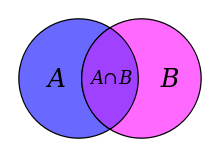Axiom of union
In axiomatic set theory and the branches of logic, mathematics, and computer science that use it, the axiom of union is one of the axioms of Zermelo–Fraenkel set theory, stating that, for any set x there is a set y whose elements are precisely the elements of the elements of x. Together with the axiom of pairing this implies that for any two sets, there is a set that contains exactly the elements of both.
Formal statement
In the formal language of the Zermelo–Fraenkel axioms, the axiom reads:
or in words:
- Given any set A, there is a set B such that, for any element c, c is a member of B if and only if there is a set D such that c is a member of D and D is a member of A.
or, more simply:
- For any set , there is a set which consists of just the elements of the elements of that set.
Interpretation
What the axiom is really saying is that, given a set A, we can find a set B whose members are precisely the members of the members of A. By the axiom of extensionality this set B is unique and it is called the union of A, and denoted . Thus the essence of the axiom is:
- The union of a set is a set.
Note that the union of A and B, commonly written as , can be written as . Thus, the ordinary construction of unions is trivial given the axiom of pairing.
The axiom of union is generally considered uncontroversial, and it or an equivalent appears in just about any alternative axiomatization of set theory.
Note that there is no corresponding axiom of intersection. If A is a nonempty set containing E, then we can form the intersection using the axiom schema of specification as
- {c in E: for all D in A, c is in D},
so no separate axiom of intersection is necessary. (If A is the empty set, then trying to form the intersection of A as
- {c: for all D in A, c is in D}
is not permitted by the axioms. Moreover, if such a set existed, then it would contain every set in the "universe", but the notion of a universal set is antithetical to Zermelo–Fraenkel set theory.)
References
- Paul Halmos, Naive set theory. Princeton, NJ: D. Van Nostrand Company, 1960. Reprinted by Springer-Verlag, New York, 1974. ISBN 0-387-90092-6 (Springer-Verlag edition).
- Jech, Thomas, 2003. Set Theory: The Third Millennium Edition, Revised and Expanded. Springer. ISBN 3-540-44085-2.
- Kunen, Kenneth, 1980. Set Theory: An Introduction to Independence Proofs. Elsevier. ISBN 0-444-86839-9.
